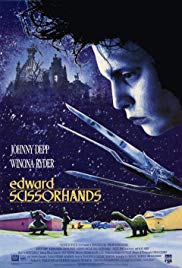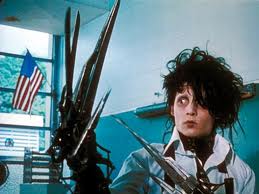Rationale:
Edward Scissorhands provides an opportunity to review literary devices which have been taught in prior lessons and to exercise writing skills, using a popular movie. In the alternative, teachers can edit the materials to focus on teaching about a few literary devices and show how they are used in a story told by a popular film.
Objectives/Student Outcomes:
Students will review and confirm existing knowledge concerning literary devices, exercise critical thinking, and practice writing expository paragraphs. In the alternative, teachers can edit the materials, so that students will learn about a few literary devices, see their use in a story and in a movie, and practice their writing skills.
Listing Literary Devices Used in the Story – Student Handout
Delete any literary devices which are not appropriate for the class watching the film. Teachers should feel free to substitute definitions that they prefer or which are used in their curriculum materials. Click here for a version of the handout in a word processing program suitable to be distributed to the class or modified by the teacher. Review the handout with the class or have students read it before watching the film.
A List of Literary Devices
1. Allegory: the use of characters or events in an effort to make a connection to characters or events that occur in life; similar to parable or fable.
2. Anachronism: elements of scenery of characters that do not fit into the time period presented in the work.
3. Antagonist: the character or force in the story that works against the protagonist and is responsible for the conflict that drives the story.
4. Complication: an element of plot that bring more problems or erect barriers for the story’s protagonist.
5. Denouement: the final unwinding of the elements of plot brought about by resolution.
6. Empathy: a feeling of identification with a character or a situation in a story.
7. Expository Phase: the first part of a story that introduces time period, setting, characters, and conflict.
8. Fantasy: the use of unreal situations, events, and characters in a story.
9. Flashback: returning to an earlier time in the story to reveal something important to understanding the overall meaning of the work.
10. Framework Narrative: a plot device that opens and closes with a narrator who is telling the story; the story is thus framed within the limits of the narrator’s experience.
11. Hyperbole: exaggeration or overstatement for dramatic effect.
12. Imagery: the use of description or pictures that create sensory responses.
13. Irony: there are several types; all of them involve a difference between what is perceived or expected and what is intended. Verbal irony is a statement in which what is said is the opposite of what is meant. Situational irony occurs when there is a meaningful discrepancy between what is intended or expected and what actually happens. Dramatic irony occurs when there is a contrast between the reality perceived by one or more of the characters and what is known by the audience or the reader.
14. Lampoon: a satirical presentation of a character or a situation that holds the character up to ridicule or attack.
15. Metaphor: the comparison between unlike objects which equates one to the other.
16. Moral: the lesson learned through the resolution of the conflict in the story.
17. Motif: any repeated element in a work that points in the direction of a theme or that serves as a unifying agent.
18. Pathos: the quality in literature which stimulates a deep sense of pity, sympathetic sorrow, or tenderness in the audience or reader.
19. Persona: the role a character assumes in the presentation of the story.
20. Plot Line: the unfolding of the story, including exposition, rising action, climax, resolution, and denouement.
21. Point of View: the perspective from which the story is told; point of view may be omniscient or limited; it may be first or third person.
22. Protagonist: the central character in the conflict in a story with whom the observers’ sympathies lie.
23. Symbolism: the use of an object to suggest an idea.
24. Theme: the central meaning of the work.
25. Tone: the author’s or director’s attitude toward the subject of the work shown through the pervasive emotion presented.
[End of Student Handout]
Writing Descriptive Paragraphs Containing Literary Analysis
To provide practice in writing short descriptive paragraphs, teachers may want to pause the film at an appropriate point and allow students time to write one or more paragraphs described in the assignments set out below. Students should be provided with a rubric regarding length of paragraph, topic sentences, the use of details to support conclusions or opinions, and any other criteria by which their efforts will be measured.
SETTING
1. Write a description of the suburban neighborhood in which Peg lives and into which she brings Edward. Be sure to focus on the use of color and conformity in terms of lawns and the shape and size of structures. End with an opinion about the quality of the neighborhood.
2. Write a description of the interior of Peg’s home. Evaluate the aesthetic quality of the way in which Peg’s home was decorated.
3. Write a description of the castle from which Edward emerges into the suburbs. Begin with a distant look at the structure from the view of the suburbs and then describe details about the plants, the interior, the assembly line of robots, etc.
CHARACTER DEVELOPMENT
1. Write a one paragraph description of three female characters who play important roles in illustrating the mentality of the suburban community. In each paragraph, provide a description of the important traits of the character and come to an opinion about the stereotype that the character represents.
2. Write a one paragraph description of three neighborhood men who appear in the barbecue scene. Describe the stereotypes presented by each of these characters and justify your opinion.
3. Describe the character of Peg as she is shown early in the film and how she begins to see things differently as the story advances. Write about how she looks, what she says, how she feels, and what she does.
4. Describe the character of Esmeralda. Write about how she looks, what she says, how she feels, and what he does. Pay close attention to how her words and actions add danger and fear to Edward’s experience in the suburbs.
5. Describe the character of Jim. Write about how he looks, what he says, how he feels. and what he does. Pay close attention to how his words, his jealousy, and his intolerance endanger Edward.
6. Describe the character of Joyce. Write about how she looks, what she says, how she feels, what she does, and how her sexual frustration leads to danger for Edward.
7. Describe the character of the old inventor who created Edward. Write about how he looks, what he says, how he feels, and what he does.
8. Describe Edward, including his facial expressions, the colors he wears, his way of walking, his voice, and his affect.
IDEAS
1. Analyze the attitude the film takes toward suburbia.
2. Analyze how increased intolerance develops in the community due to gossip, innuendo, mistakes, and lies.
3. Analyze the progress from early interest in Edward to a desire to exploit his unique talents to fear and finally rejection.
4. Analyze the film’s use of stereotypes in the story’s presentation.
5. Analyze the progress of Kim’s feelings and the changes she experiences in her relationship with Edward.
6. Identify and evaluate the theme of the movie. What is it? Do you agree with it?
EVALUATION
1. Evaluate the film’s presentation of various literary devices used to unfold the story. Select at least three of the devices from the list of literary terms presented in the Student Handout.
2. Evaluate the film’s success as an allegory. Does the film succeed in its efforts to leave the viewers with a clear statement of the problems of a conformist society?
3. Evaluate the artistic merit of the settings used in the film, both interior, such as in the homes or in the castle, and exterior, such as the buildings, yards, and the suburban neighborhood as a whole.
4. Evaluate the film’s presentation of its message. Is it effective?
5. Evaluate the film’s ending in terms of the level of satisfaction offered to its viewers. Be sure to address the tying together of the opening and ending scenes where an old woman tells the tale of Edward’s experience in suburbia.
Writing Summaries of Parts of the Movie
1. Summarize the expository phase of the film.
2. Summarize one of the complications that occur as the film progresses. Possible complications to summarize include:
- Joyce’s attempt to seduce Edward;
- Peg’s consistent attempts to use Avon products to cover Edward’s scars;
- The growing problem between Jim and Edward. Be sure to include the effort to break into Jim’s home;
- Esmeralda’s influence in fomenting fear of Edward;
- The events that shift Kim’s loyalty from Jim to Edward;
- The progress of Edward’s plant-trimming and hair-cutting skills.
3. Summarize the final episode in which Jim and Edward fight and in which Kim finds a way to save Edward from the angry mob.
4. Write a summary of the plot as a whole. Be sure to include the ending.



